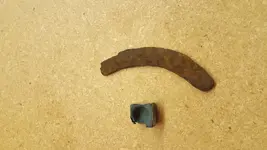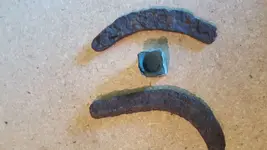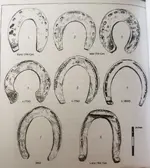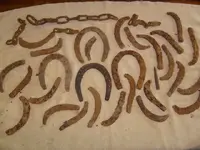You are using an out of date browser. It may not display this or other websites correctly.
You should upgrade or use an alternative browser.
You should upgrade or use an alternative browser.
How to identify horse shoes
- Thread starter allison86
- Start date
FreeBirdTim
Silver Member
- Joined
- Sep 24, 2013
- Messages
- 3,945
- Reaction score
- 7,353
- Golden Thread
- 1
- Location
- Scituate, RI
- 🥇 Banner finds
- 1
- Detector(s) used
- Garrett AT Pro
- Primary Interest:
- All Treasure Hunting
The size of the horseshoe is based on the size of the animal. Thickness will vary, depending on how worn the shoe was when the horse lost it.
Trying to put a date on horseshoes is frustrating. Even tougher if you only have part of one.
Trying to put a date on horseshoes is frustrating. Even tougher if you only have part of one.
sawmill man
Hero Member
No, horse shoes are not one size fits all, they are all diff types ,sizes and styles out there from pony shoes a couple inches across to shoes for mules and draft horses on up.
sawmill man
Hero Member
someone correct me if im wrong but my take on finding half of shoes are the end wears thin over alot of use making it rust away quicker ,leaving the sides for us to find. i have made some for other loggers with cleats welded to the bottoms mostly on the toe .so if you find one like that its been used on a log woods work mule . you might look up horse shoes and find a list of types of shoes.
CoilyGirl
Gold Member
sawmill man
Hero Member
Absolutely ,theres never a stupid question .
- Joined
- Jun 9, 2013
- Messages
- 7,107
- Reaction score
- 11,057
- Golden Thread
- 0
- Location
- Middle TN. area
- Detector(s) used
- White XLT Spectrum E-Series
- Primary Interest:
- Metal Detecting
Thanks I know it's a stupid question I am still learning this type of.stuff
I don't think it's a stupid question.... and if it is I beat you to it awhile back.
 I have found A LOT of partial shoes (like yours) and some whole ones. This old dirt road behind my house winds through the woods to the Duck River about a mile away. Just about all I find is horseshoes, wagon parts and chain links. I believe it was the main road between Centerville and Columbia TN. way back in the day. Then they ferried across the river. I've never MD'd back there yet but I bet it would be a great spot too.
I have found A LOT of partial shoes (like yours) and some whole ones. This old dirt road behind my house winds through the woods to the Duck River about a mile away. Just about all I find is horseshoes, wagon parts and chain links. I believe it was the main road between Centerville and Columbia TN. way back in the day. Then they ferried across the river. I've never MD'd back there yet but I bet it would be a great spot too. I think you or I could get the first BANNER horseshoe if we keep plugging buddy.... BEST OF LUCK TO YA!!!!

Attachments
FreeBirdTim
Silver Member
- Joined
- Sep 24, 2013
- Messages
- 3,945
- Reaction score
- 7,353
- Golden Thread
- 1
- Location
- Scituate, RI
- 🥇 Banner finds
- 1
- Detector(s) used
- Garrett AT Pro
- Primary Interest:
- All Treasure Hunting
No, horse shoes are not one size fits all, they are all diff types ,sizes and styles out there from pony shoes a couple inches across to shoes for mules and draft horses on up
Yup, I've found all different sizes over the past three years. Still haven't figured out a way to hang them with the points facing up, though! LOL!
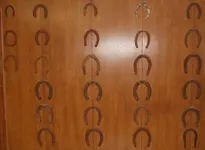
relic nut
Silver Member
Dude, you're dumping out all the luck!! Clean the rust out of the holes on each side and use two brad nails.Yup, I've found all different sizes over the past three years. Still haven't figured out a way to hang them with the points facing up, though! LOL!
View attachment 1347950
Seen a guy at a show once who was displaying his detector finds. He had a five gallon bucket full of horse shoes and was given them to the kids that came by. They loved it. Not so sure about Mom and Dad. Lol
HH RN
BosnMate
Gold Member
- Joined
- Sep 10, 2010
- Messages
- 6,916
- Reaction score
- 8,441
- Golden Thread
- 0
- Detector(s) used
- Whites MXT, Whites DFX, Whites 6000 Di Pro
- Primary Interest:
- Other
A brief lesson on horse shoes. First -- the above picture that is attempting to date horse shoes. All those style of shoes are being used today. Any horse shoer that does corrective work, and makes hand made shoes will make shoes that resemble the ones pictured. The best way to date a horse shoe is what else did you find in the area that is date-able.
The hoof wall of a horses foot will grow an average of 3/8's inch a month. Wild horses will wear their feet off at about that rate, however horses kept on nice soft pasture will need their feet trimmed to keep them from getting too long and breaking up. Horses being ridden or driven will be forced to wear their feet down at a faster rate than they grow, and their feet get tender and the horse goes lame. The answer to that is to put iron shoes on the animal. When the horse or mule is shod, the hoof wall is trimmed back and the foot leveled, the shoe is shaped to fit the foot and nailed on. Now the hoof wall is protected and is going to grow 3/8's inch per month. If the foot is allowed to grow to long, there are a number of things that can go wrong, which I won't go into, but worse case, the end result can end up with a lame horse. Therefore the Army required the cavalry horses be shod every six weeks. The horse would get new shoes, 6 weeks later the farrier would cut the clinches off the nails, and pull the shoe. He would then trim the excess hoof wall, and nail the same shoe back on, which is call "resetting the shoe." Then 6 weeks after the shoe has been reset, they are usually so worn and thin that those shoes are pulled and new ones put on. Now, just because the army did it that way doesn't mean everybody does it that way, and in fact most people don't. Shoeing a horse is expensive, and people tend to leave them on the horse as long as possible. Depending on the hardness of the ground, and the length of time the shoe is left on the foot, or if the shoe has been reset, an iron horse shoe can wear in two at the toe. In another life I packed animals and rented saddle horses into an area in the High Sierra Nevada called Desolation Valley. The trails had no dirt on them, the country was solid granite, and the horses got lots of miles. Many times the new shoes on the horse would wear in two in a month. One more thing, horses and mules have different shaped feet, the mule foot is narrower and the hoof wall straighter than a horse. Also, the front foot of a horse is shaped different than a back foot. There are many different shapes and styles of horse shoes, and different traction devices used, that I'm not going to get into, it's just to much. Different shoes are used to correct certain things about the way the horse travels, or help heal an injured foot, or for traction on ice or in mud or when pulling a heavy load. I'll include a couple of pictures to show the difference shape of the front, back and mule feet.
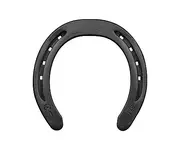
The shape of the front foot.
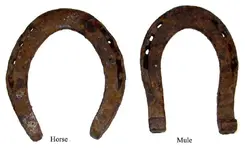
The shape of the hind foot, and a mule shoe for comparison.
The hoof wall of a horses foot will grow an average of 3/8's inch a month. Wild horses will wear their feet off at about that rate, however horses kept on nice soft pasture will need their feet trimmed to keep them from getting too long and breaking up. Horses being ridden or driven will be forced to wear their feet down at a faster rate than they grow, and their feet get tender and the horse goes lame. The answer to that is to put iron shoes on the animal. When the horse or mule is shod, the hoof wall is trimmed back and the foot leveled, the shoe is shaped to fit the foot and nailed on. Now the hoof wall is protected and is going to grow 3/8's inch per month. If the foot is allowed to grow to long, there are a number of things that can go wrong, which I won't go into, but worse case, the end result can end up with a lame horse. Therefore the Army required the cavalry horses be shod every six weeks. The horse would get new shoes, 6 weeks later the farrier would cut the clinches off the nails, and pull the shoe. He would then trim the excess hoof wall, and nail the same shoe back on, which is call "resetting the shoe." Then 6 weeks after the shoe has been reset, they are usually so worn and thin that those shoes are pulled and new ones put on. Now, just because the army did it that way doesn't mean everybody does it that way, and in fact most people don't. Shoeing a horse is expensive, and people tend to leave them on the horse as long as possible. Depending on the hardness of the ground, and the length of time the shoe is left on the foot, or if the shoe has been reset, an iron horse shoe can wear in two at the toe. In another life I packed animals and rented saddle horses into an area in the High Sierra Nevada called Desolation Valley. The trails had no dirt on them, the country was solid granite, and the horses got lots of miles. Many times the new shoes on the horse would wear in two in a month. One more thing, horses and mules have different shaped feet, the mule foot is narrower and the hoof wall straighter than a horse. Also, the front foot of a horse is shaped different than a back foot. There are many different shapes and styles of horse shoes, and different traction devices used, that I'm not going to get into, it's just to much. Different shoes are used to correct certain things about the way the horse travels, or help heal an injured foot, or for traction on ice or in mud or when pulling a heavy load. I'll include a couple of pictures to show the difference shape of the front, back and mule feet.

The shape of the front foot.

The shape of the hind foot, and a mule shoe for comparison.
Last edited:
Similar threads
Users who are viewing this thread
Total: 1 (members: 0, guests: 1)

